| The Daily Show With Jon Stewart | Mon - Thurs 11p / 10c | |||
| War on Christmas - Historical Fact-Checking | ||||
| ||||
Wednesday, December 14, 2011
Jon Stewart Gets Screwed by the History Channel!
So sometime last week Jon Stewart, while responding to the "war on Christmas," included a clip on his show from the History Channel. Now this quote ended up being wrong and for that PolitiFact gave him a pants on fire rating. Now Jon Stewart admits when he is wrong and is normally pretty quick to admit it which is what he does in the video below. I wanted to post this because in the past Comedy Central, with some commentary from me, have showed that the History Channel is no longer what it claims to be and it saddens me.
Tuesday, December 6, 2011
Monckton the Response
So over the course of a little while ago Potholer54 did a video series discussing the claims of Lord Christopher Monckton(see here part 1, part 2, part 3, part 4, and part 5 which you should probably see if you haven't already). Well someone posted a summary of those videos and Monckton responded on the Watts Up With That blog. To that Potholer54 made a 2 video response, below, refuting those claims by Monckton and how he continues to avoid the evidence.
The Hockey Stick Graph is not all there is
I have heard the claim many times in the past that the only reason that we think that climate change is happening is because of the famous hockey stick graph done by Michael Mann and the rest of his research team. Well that isn't true and Greenman3610 does a great job breaking down that argument and showing what evidence there actually is.
Monday, December 5, 2011
Russell Cave National Monument

Location: Jackson County in the Northeast corner of Alabama near the border with Tennessee and Georgia.
Introduction:
As my wife and I are trying to complete our tours of National Park Service operated properties we sometimes have to go off the beaten path to find them, Big Bend while large and famous park is just one example, we have hit several others in the past, before I started blogging hence why they aren't on here, as well though. I like visiting the smaller and/or less visited parks because it is easy to say to brag about the random ones you get, but I also would like to see some of these parks get more visits so I want to make sure that I get to blogging about them. We came across Russell Cave National Monument while on a trip from Nashville to Chattanooga (note there was another park visited in the process so expect another post soon) and we noticed it on the NPS find a park map so we figured we pretty much had to hit it up.
Russell Cave National Monument (Wikipedia page) is one of the smaller parks I have ever visited but if anything that adds to its flair. Driving through back roads in northern Alabama has never been on a wish list of mine, note I'm not saying I have a problem with it just never saw myself doing it, but to get to the park you need to do this. When we arrived on the warm early October day (yes I have been sitting on this post for a while so what) we ate lunch in the nice little picnic area in the front of the park. It was a weekday so they didn't have any events going on, they do on some weekends, so we got a personal tour of the visitor center which is always nice and had a great experience.
Geographically Russell Cave is in the southern Appalachian Mountains and sits in a valley just a short distance from the Tennessee River. The trail system is not extensive, there are only 2 and they both branch off the same base trail, but they allow you to see the "cave" as well as other geographic formations typical of Karst systems, such as a major sinkhole. The main trail that goes to the cave is on a boardwalk so is very accessible to anyone from those in wheelchairs to those with strollers and overall the park is a good stop for people traveling through the region to stop and eat a picnic lunch and to stretch their legs, just remember to sign the guestbook inside the visitor center if you do stop.
Visitors to Russell Cave are no longer able to go very deep into the cave, I would guess for safety reasons since it wasn't a very developed cave, but there is a little overhang area where there are displays. The actual portion of the cave that, according to our guide, they used to allow people to go into has a river flowing into it that you can actually see flow from under a rock wall near where the sinkhole is. The cave has a long history with humans where it served as a likely home to humans for at least 8,000 years. This is actually why the Russell Cave is a national monument. During the 50s the cave was the site of excavations by the Smithsonian and National Geographic, there were a couple of papers published on it and Nat Geo published an article titled Life 8,000 years ago uncovered in an Alabama cave (I can't find a spot to link for it online so if someone knows where I can find it let me know in the comments), I will talk more about the archeological excavations in the geology section. A short time later the National Geographic Society, who owned the land at the time, donated the land to the NPS which allowed for the creation of Russell Cave National Monument.
Geology:
 During the Mississippian much of the western portion of the current Appalachian Mountains was under, or near a, shallow warm ocean. The Mississippian, for those who might not know, is part of the Carboniferous which is named for the large number of coal formations from around the world. In the Russell Cave area the sea was shallow and warm which allowed for a large limestone deposit to form. It is likely that there are many reef building organisms preserved in the formation but I didn't get close enough to the rocks to actually get a chance to look. As I have explained in the past (see here and here), limestone is dissolved away by water that is slightly acidified by CO2. Since I have explained this in the past I wont say anything more here.
During the Mississippian much of the western portion of the current Appalachian Mountains was under, or near a, shallow warm ocean. The Mississippian, for those who might not know, is part of the Carboniferous which is named for the large number of coal formations from around the world. In the Russell Cave area the sea was shallow and warm which allowed for a large limestone deposit to form. It is likely that there are many reef building organisms preserved in the formation but I didn't get close enough to the rocks to actually get a chance to look. As I have explained in the past (see here and here), limestone is dissolved away by water that is slightly acidified by CO2. Since I have explained this in the past I wont say anything more here. The current Appalachian Mountains have slowly been being uplifted further and further west as time as gone on. This uplift is caused by an isostatic response caused by sediment from the eroding mountains being loaded onto the edge of the continent. As the mountains are uplifted the rivers that flow through the region cut down through the rocks, this is why there are large valleys along the New River in West Virginia, as they try to stay at base level. In the area near Russell Cave the Tennessee River has been working hard to cut down through the rocks and it is likely either the river itself or one of its tributaries cut down to the rocks and exposed Russell Cave.
We know that there were humans in North America by at least 10,000 years ago. Humans like to use premade shelters for safety etc and sometime around 8,000 years ago we know humans first appeared in Russell Cave. Humans were able to use the cave because the roof fell in, due to the typical karst processes, and a build up of sediment around the portions of the roof that fell in. This sediment made a dry area above what would have been a typical flood level, although large flood would likely have still covered the area. The sediment trapped evidence of the humans who used the cave including arrowheads, fish hooks, and bones of killed animals. The excavations have found influence of multiple cultures through time but there is little current excavation, that I know of at least, so there may even be some evidence of earlier times. I would not be surprised if under the level last excavated even if there aren't humans it is likely that there will be some fossilized animal remains but I can't know for sure without further excavations.
More Pictures: All photos in this post were taken by the author ask for permission if you want to use any of them.

Looking into the cave.

One of the displays in the cave.

The creek that formed the cave coming out of the rock wall right nearby that has a sinkhole on the otherside.
Further Reading:
Miller, C.F., 1956. Life 8,000 years ago uncovered in an Alabama cave. National Geographic Magazine. (Seriously someone find this for me please)
National Park Service Series homepage
A Vaccine Cover-up!
No! but C0nc0rdance breaks down a recent claim that says something very similar to that. It should be worth noting that my big post on vaccines and Autism has seen a lot of action recently not sure why just found it interesting.
Climategate the Second
Many of you might remember a few months ago when a bunch of emails for scientists at the East Anglia climate research group were hacked and released and that skeptics claimed proved that people had been lying about climate change. Well it didn't actual prove that (for evidence see here, here, and here) but that isn't keeping skeptics from hailing a new release of e-mails released from the same group as more evidence of the lie of global climate change. But not to worry Potholer54 is on the case and goes through all the emails and shows they don't actually show what people are claiming they show.
Wednesday, November 16, 2011
Drought and Climate Change
Another great video by Greenman3610 talking about how climate change is effecting the drought that is destroying agriculture in much of Texas right now.
This Strawman is Getting Old
The last of the Golden Crocoduck videos has been posted by Potholer54 and while there isn't going to actually be voting this year, for reasons you can see here, I figured I would still post this video. I have heard this nonsense so many times and have heard it refuted but as long as creationists keep using it it will keep having to be debunked.
Monday, November 14, 2011
History Channel
So anyone who has followed me for a little while on Twitter will know my feelings about what the History Channel (Wikipedia page), and to a lesser but still important extent Discovery Channel, has become, and I am not the only one (but I can't find a relevant link right now so please post some in the comments if you come across them). A channel that used to have mostly shows that were based on true history now has shows called Ancient Aliens and MonsterQuest that contain very little to no actual evidence except for maybe one piece of evidence that we "can't explain", yet. It also contains shows that seem to have very little to do with true history such as Ice Road Truckers, or all of the equally "relevant" IRT shows. I will admit that sometimes I will take a guilty pleasure in watching one or two of those shows but it has been so long since I have regularly tuned in to History Channel that when my channel guide showed Vietnam in HD (Wikipedia page which as of the time of writing looks pretty new), which must have been a new show, I was caught off guard but didn't stop because I figured that was one of those series you had to see from the start. Also the History Channel owns what used to be known as History International (now H2) and that used to show more shows like what History Channel used to show but has now become nothing more than more of the same. It was also why I was glad to see this week's South Park make fun of what the History Channel has become (relevant clips below, 2 of which are below the fold, and the full episode can be found here). Now I should state that there are good shows on History/H2 but to me it seems that they are trying to get away from history and more on to entertainment which kind of leads too a little bit of false advertising.
Evolution and Thanksgiving
SMBC is at it again this time combining evolution with thanksgiving also dinosaurs because who doesn't love dinosaurs. Yes I know this was posted on their site almost a week ago but I have been busy.
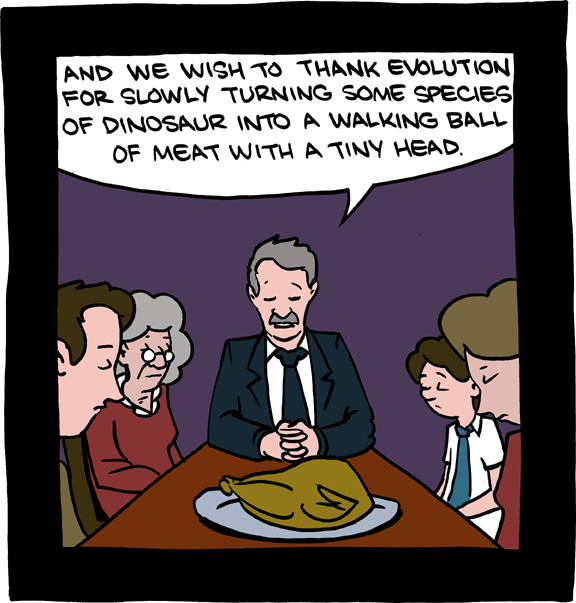

Labels:
birds,
comic,
Dinosaur,
Evolution,
fun,
funny,
Happy Thanksgiving,
Science,
SMBC,
Thanksgiving
Thursday, October 27, 2011
The Daily Show on Climate Change and those oh so evil scientists
I am sure by now most people are familiar with The Daily Show With Jon Stewart, if you aren't you must have been living under a rock. Well last night's episode Jon discussed how the new BEST data continues to support the conclusion that the earth is warming.
Now while that wasn't perfect, the "climategate" scandal was a lot of stuff taken out of context and Jon doesn't ever acknowledge that, he does point out how no body is talking about this, well except for him. That is why I am trying to let everyone know.
Now naturally with more evidence supporting climate change the next "logical" question is what are scientists up to? For this he sends Aasif Mandvi to find out in the clip below the fold.
| The Daily Show With Jon Stewart | Mon - Thurs 11p / 10c | |||
| Weathering Fights | ||||
| www.thedailyshow.com | ||||
| ||||
Now while that wasn't perfect, the "climategate" scandal was a lot of stuff taken out of context and Jon doesn't ever acknowledge that, he does point out how no body is talking about this, well except for him. That is why I am trying to let everyone know.
Now naturally with more evidence supporting climate change the next "logical" question is what are scientists up to? For this he sends Aasif Mandvi to find out in the clip below the fold.
Why we need NASA!
I have made the case in the past that NASA is important to our understanding of science and how the universe works, oh and that it is just cool as well. Well Neil deGrasse Tyson (Twitter and Facebook), a great popularizer of science in general and space in particular (oh and also an Astrophysicist), has been saying similar things, although much more elegantly than I, and that trend apparently continued this year at TAM. This video was put together by pointmanzero using some amazing images of space and Tyson's speech from TAM and it is quite moving and even without seeing him you can tell how much Dr. Tyson loves this stuff.
H/T lefayad1991
H/T lefayad1991
The "BEST" Climate Data
I have been quite busy this month and don't expect that to slow down any time soon but I will try to get a few posts together before I leave town for a few days early next week. Anyway I am sure most of you have heard that the UC Berkeley team released their climate data earlier this week and, shocking to no one but the climate change denialists, it feel in line with all previous climate change data. Greenman3610 was quick to put out a video to show this and it is up to his normal quality.
Friday, September 30, 2011
Happy 150th Birthday Archaeopteryx
I was hoping to have the book Archaeopteryx: Icon of Evolution by Peter Wellnhofer finished by today but as life has gotten in the way I have not been able to do that, hmm maybe I should read not that I am feeling inspired...
150 years ago today (today being 30 September 2011 and 150 years ago being 30 September 1861) an article was published by Hermann von Meyer which while only being 2 paragraphs long the first of which said this [German from the H. v. Meyer (1861) and English translation from Wellnhofer (2009)]
Archaeopteryx is an amazing find and even if it isn't a true bird it represents more than that. The specimens showed transitions between animals it has the feathers and many of the body parts of a bird but they are not completely bird like, it also has long claws and the teeth of the dinosaurs. This showed that dinosaurs and birds were related and while Darwin never used it as an icon for evolution it truly is one. 150 years ago paleontology was still young and we were still trying to understand what we were looking at to find an animal with feathers and dinosaur traits then was amazing and never heard of, after all animals fit neatly into their groups. Today a feathered dinosaur gets its five minutes of fame, nope doesn't even get a full 15 anymore, and then disappears where only paleontologists seem to remember it. It is amazing to see how far we have come! So in honor of that I figured I would share some links to other sites celebrating the day, links to my posts on closely related subjects (if I find more I will post them and if you have anymore feel free to share them in the comments), and some of the pictures I took of one specimen of Archaeopteryx, the Thermopolis Specimen, I was lucky enough to see. Enjoy and do something to celebrate the amazing animal that became part of the scientific record today!
Links:
The Witmer Lab is celebrating by unveiling a webpage that will link to some of their fancy 3D pdfs so I will let you go to their announcement page.
David at History of Geology talks briefly about the first feather.
Dinosaur Tracking gets a rare guest post from the associate web editor for Smithsonian.com Brian Wolly on his recent trip to Munich and getting to see the, surprisingly nick-named, Munich Specimen
My Pages:
My visit to the Houston Museum of Natural Science in which I got to see the Thermopolis Specimen.
My book review on the book Solnhofen: A Study in Mesozoic Palaeontology by K.W. Barthel, N.H.M. Swinburne, and S. Conway Morris which is the locality from where all the Archaeopteryx specimens have been found.
Pictures (below the fold to speed up page loading and all images are by the author)
150 years ago today (today being 30 September 2011 and 150 years ago being 30 September 1861) an article was published by Hermann von Meyer which while only being 2 paragraphs long the first of which said this [German from the H. v. Meyer (1861) and English translation from Wellnhofer (2009)]
Nachtrüglich zu meinem Schreiben vom 15 verflossenen Monats Kann ich Ihuen nunmehr mittheilen, dass ich die Feder von Solenhofen nach allen Richtungen hin genau untersucht habe und dabei zu dem Ergebniss gekommen bin, dass sie eine wirklich Versteinerung des lithographischen Schiefers ist und vollkommen mit einer Vogel-Feder übereinstimmt. Zugleich erhalte ich von Herrn Obergerichtsrath Witte die Nachricht, dass das fast vollständige Skelet eines mit Federn bedeckten Thiers im lithographischen Schiefer gefunden worden sey. Von unseren lebenden Vögeln zeige es manche Abweichung. Die von mir untersuchie Feder werde ich mit genauer Abbildung veröffentlichen. Zur Bezeichnung des Thieres halte ich die Benennung Archaeopteryx lithographica geeignet.Obviously there has been some confusion if the feather should be the type specimen or the fossil of the whole animal, which would eventually become the London Specimen, but the ICZN has clarified it as the animal is the type specimen so no worries anymore.
[In addition to my letter of the 15th of last month I can now report that I have carefully studied the feather in all respects with the result that it is a real fossil from the lithographic shale and perfectly agrees with a bird's feather. Coincidentally I received a message from the "Obergerichtsrath" Witte that an almost complete skeleton of an animal covered with feathers was found in the lithographic shale. It showed several differences from living birds. The feather I had studied will be published along with a detailed description. For the name of the animal I consider Archaeopteryx lithographica as suitable.](emphasis mine)
Archaeopteryx is an amazing find and even if it isn't a true bird it represents more than that. The specimens showed transitions between animals it has the feathers and many of the body parts of a bird but they are not completely bird like, it also has long claws and the teeth of the dinosaurs. This showed that dinosaurs and birds were related and while Darwin never used it as an icon for evolution it truly is one. 150 years ago paleontology was still young and we were still trying to understand what we were looking at to find an animal with feathers and dinosaur traits then was amazing and never heard of, after all animals fit neatly into their groups. Today a feathered dinosaur gets its five minutes of fame, nope doesn't even get a full 15 anymore, and then disappears where only paleontologists seem to remember it. It is amazing to see how far we have come! So in honor of that I figured I would share some links to other sites celebrating the day, links to my posts on closely related subjects (if I find more I will post them and if you have anymore feel free to share them in the comments), and some of the pictures I took of one specimen of Archaeopteryx, the Thermopolis Specimen, I was lucky enough to see. Enjoy and do something to celebrate the amazing animal that became part of the scientific record today!
Links:
The Witmer Lab is celebrating by unveiling a webpage that will link to some of their fancy 3D pdfs so I will let you go to their announcement page.
David at History of Geology talks briefly about the first feather.
Dinosaur Tracking gets a rare guest post from the associate web editor for Smithsonian.com Brian Wolly on his recent trip to Munich and getting to see the, surprisingly nick-named, Munich Specimen
My Pages:
My visit to the Houston Museum of Natural Science in which I got to see the Thermopolis Specimen.
My book review on the book Solnhofen: A Study in Mesozoic Palaeontology by K.W. Barthel, N.H.M. Swinburne, and S. Conway Morris which is the locality from where all the Archaeopteryx specimens have been found.
Pictures (below the fold to speed up page loading and all images are by the author)
Tuesday, September 27, 2011
2011 Arctic Sea Ice Minimum
So it appears we have reached the sea ice minimum for 2011 and it is depressingly low, close to the record low of 2007. Greenman3610 has a video wrapping up the sea ice minimum for the year.
Below the fold is a video by NASA explaining the importance of Arctic sea ice, I figured 2 videos in one post on my main page would probably slow down the page loading too much
Below the fold is a video by NASA explaining the importance of Arctic sea ice, I figured 2 videos in one post on my main page would probably slow down the page loading too much
Thursday, September 22, 2011
Burden of Proof
So I wanted to publish this last week when the video first came out but I had some technical problems with blogger and therefore didn't sorry. In this video David Mitchell pretty much says what I have been saying for a long time, even if the earth isn't warming and/or humans aren't the ones doing it then why shouldn't we just make a better world to make a better world?
Tuesday, September 13, 2011
Monday, September 12, 2011
I Want One!
Having more and more energy efficient houses and buildings is beneficial not just to the people who make the technology but in the long run to the people who live in the houses as Greenman3610 shows in his latest video. We have been seeing over the last few years more and more houses like these popping up around the country and as far as houses are concerned it is definitely the wave of the future. As the title of my post suggests I would really like one but that isn't going to happen for sometime. Right now though I would just take a more energy efficient apartment building but right now most apartments don't have any reason to make their buildings more energy efficient, why should they in order to maximize profit for them they need must put in the cheapest stuff available and fix broken parts with cheap parts. I want to make something clear that I don't have a problem with them trying to make a profit but I feel you could charge more rent if people didn't have to pay as much for their utilities they would want to move into your place, ok that is the end of that rant but hey its my blog. Enjoy the video.
Friday, September 9, 2011
Read the Paper!!
Potholer54 shows why it is important not to just take anyone's word on what a paper says, that includes his and mine, but to actually read it.
Friday, September 2, 2011
Ideas?
So I know the blogging here has been sporadic at best recently and for that I am sorry I just have been really busy with life. Recently I noticed that one post from January has seen a surprising number of hits so I didn't know if there was something in that post you all liked and wanted to see more of, or is it just because I linked to it recently (although the surge started before that). So consider this a free for all I want to hear what you all want to see more of and I will try to work on some new posts for you all then feel free to talk away in the comments section.
Friday, August 26, 2011
Why We Must Vaccinate
Another great video by C0nc0rdance showing the importance of vaccination. I have covered this before, for some reason my prior post has been getting tons of hits recently, and just in the last few days a new report was released which showed, shockingly, that vaccines do not cause Autism (NPR article on the report). The report did show that vaccines have side effects, this is not surprising as almost all medicines do, but that the side effects were typically minor especially when compared to the harm the actual disease would have done.
Population
So this is something that you hear a lot coming from creationists, mostly because they are just regurgitating Kent Hovind, that the population now can only have been reached with an initial population of 2. This new video by shanedk should at least partially answer that question.
Wednesday, August 24, 2011
Big Bend National Park
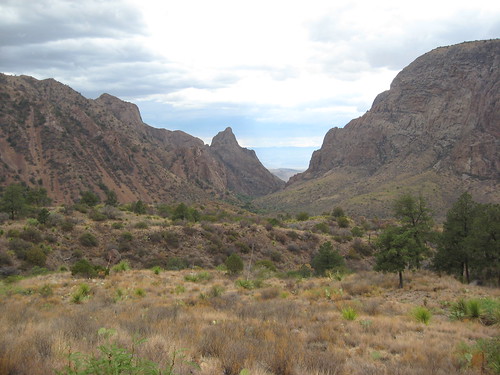
Location: Western Texas in Southernmost Brewster County along the border with Mexico.
Introduction:
I have been wanting to do a post on Big Bend for a long time, mainly because most of my fellow paleontology graduate students were doing work on material from here, but I couldn't put a post together till I had been there [Image at top looking out the Window in the Chisos by author]. Finally as I was getting ready to leave Lubbock I convinced one of the other students to drive out there with me for a couple of days so I can now say I have been even if we played tourist at the end of July and were trying not to melt the whole time we were there (note: it is hot in the desert in July).
Big Bend National Park (Wikipedia page) is not a national park that you just happen upon you have to make the conscious effort to get there. The fact is even the county it is in is off most peoples beaten path, there are no interstates that go through the county, and with a population of ~10,000 people very few people will ever visit the area. Big Bend is also in the middle of a desert which most people tend to avoid, especially during the hot summers which also happen to be when most tourists visit the other national parks. All of these reasons make Big Bend one of the least visited of the parks in the NPS system.
I mentioned that Big Bend is in the desert and it is part of the Chihuahuan Desert this desert extends up into New Mexico in fact 2 previous national park series posts, Guadalupe Mountains and Carlsbad, have talked about parks in this desert. Now this is not the desert that most people picture when they think desert, there are no big cacti and tons of sand. What there is instead is a very dry environment with for the most part low growing plants that have adapted to be able to live with little to no water for extended periods of time and when they do get water they make the most of it. There is plenty of mesquite as well with its long roots that reach deep for water and can find water in even the driest of environments. But there is more than just desert as the park varies from 1800 feet up to over 7000 feet there is a wide range of climatic differences. The Rio Grande and its flood plain make of a rich fertile wet soil that keeps plants growing almost year round and in the valley actually makes it quite humid. The desert has two ranges one the high desert and the other the low desert both have unique and varying vegetation types. And finally the Chisos Mountains that extend from the desert floor reaching up to the sky, the basin in them where the campsites are is over a mile high, the micro-climate here is cooler, I woke up in the morning actually cold and wanted to put on a long sleeve shirt, and more wet than the surrounding area and is the only place in the park where true trees can and do grow, also home to bears and mountain lions.
Ok I have rambled on long enough with the intro but lets just say if you happen to be nearby for whatever reason go visit Big Bend it is worth your time.
Geology:
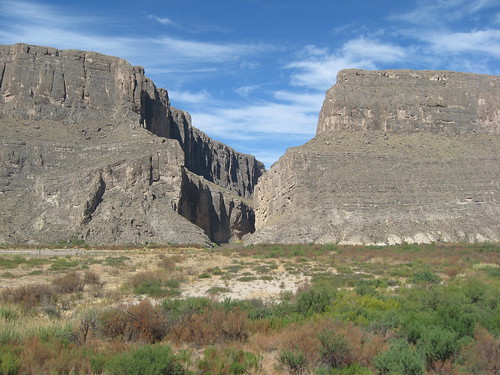 This park is so large (~800,000 acres) and has such a vast diverse geologic history that this is really only going to be an extremely brief summary of the geology of the park because I could ramble on for a long time about it [Image at left of Santa Elena Canyon by author].
This park is so large (~800,000 acres) and has such a vast diverse geologic history that this is really only going to be an extremely brief summary of the geology of the park because I could ramble on for a long time about it [Image at left of Santa Elena Canyon by author].
In the Triassic while Pangaea was still around this area of the country was exposed to the surface so unlike good chunks of the rest of the state there are no Triassic rocks in Big Bend. During the Triassic and Jurassic, however, Pangaea began to break apart this caused many of the rift valleys on the east coast of the United States and slowly started to allow for subsidence of the middle portion of the country. By the Cretaceous a large body of salt water that connected the still forming Gulf of Mexico to the Arctic Ocean, this was known as the Western Interior Seaway. This seaway was shallow and warm which is the perfect conditions for calcium carbonate secreting organisms to live in and these organisms form limestone deposits, see Guads, Carlsbad, and Mammoth Cave posts. These limestone deposits form the famous Glen Rose Formation in most of Texas along with most of the other limestone formations in the center of the state, they also form the limestone and chalk formations up into Kansas where the less famous, but equally important, Niobrara Chalk is. In the park there are thin bands of the Glen Rose but the most obvious example of this limestone is the massive limestone cut by the Rio Grande to form Santa Elena Canyon.
Late in the Cretaceous the sea level fell and the Western Interior Seaway began to recede toward the Gulf of Mexico, in the U.S. at least. As the sea level dropped river systems began to flow through the region and toward the very end of the Cretaceous portions of the park where underwater and portions where on land. During this time many dinosaurs lived in the area and in the formations that represent this time we find their fossils. The dinosaurs weren't alone during this time as the pterosaurs had grown to their largest size yet and Big Bend represents the type location of one of the largest the ~10 meter wing spanned Quetzalcoatlus northropi (Wikipedia page). The actual contact that represents the end of the dinosaurs, that famous iridium layer, is not found in the park although it should be no one has found the contact yet, although we are still looking.
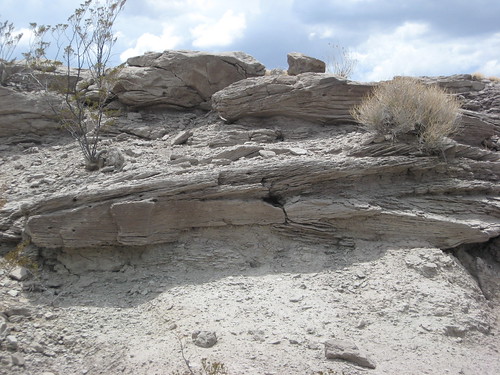 Whatever happened to the contact the area continued on being a warm wet swampy habitat through a good portion of the Eocene, fossils from the mammals that lived at this time can be seen at a roadside stop known as the Fossil Bone Exhibit in the park [photo at right of the Eocene sedimentary rocks near the fossil bone exhibit by author]. These animals were sitting on a ticking time bomb, however, because while they were living here under their feet were building up massive igneous intrusions.
Whatever happened to the contact the area continued on being a warm wet swampy habitat through a good portion of the Eocene, fossils from the mammals that lived at this time can be seen at a roadside stop known as the Fossil Bone Exhibit in the park [photo at right of the Eocene sedimentary rocks near the fossil bone exhibit by author]. These animals were sitting on a ticking time bomb, however, because while they were living here under their feet were building up massive igneous intrusions.
These igneous rocks would eventually burst through eventually and would form the Chisos Mountains. There were likely at least 3 major events of eruption and evidence throughout the park is obvious. In an area known as Tuff Canyon, tuff is a type of volcanic ash, there are ash rocks that have been heavily cut by water but in the ash layers there are evidence of lahars and lava bombs. Eventually the composition of the magma changed and it came out more runny this formed areas where you have lava being deposited on top of ash and they are exposed for many meters in elevation. The igneous rocks shaped the park and through the area there is evidence of volcanics but also plenty of evidence of intrusives as igneous dikes cross roads in several places.
Volcanism eventually stopped and the area settled tectonically but it wasn't quite done yet. As with the Guads there was at least one period of uplift formed as the western edge of the Basin and Range that uplifted many of the rocks and with the help of erosion giving us the geography we have now. The park has obviously also become a desert and this likely occurred closer to the end of the last ice age as climates every fluxed due to the change in flow patterns caused by the loss of the glaciers.
More Pictures: I have even more pictures in the Big Bend portion of my Flickr page, all photos by author.
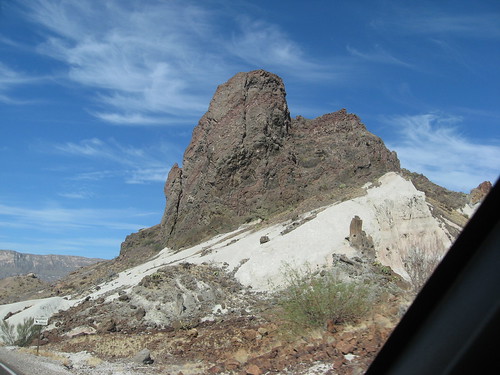
More "runny" volcanic rocks on top of an ash layer.
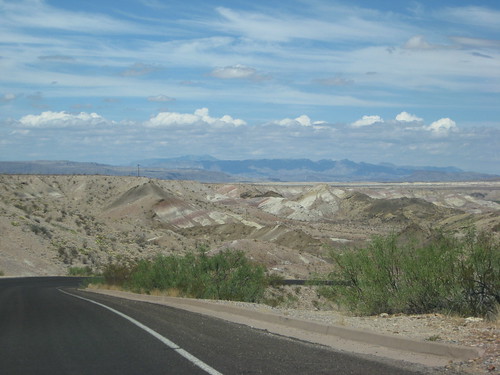
Cretaceous aged sedimentary rocks

Roadrunner
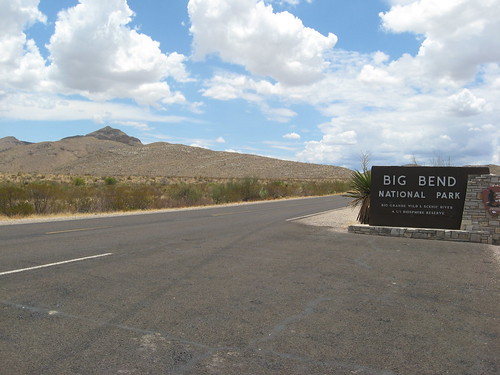
Welcome to Big Bend National Park
Further Reading:
The NPS pages on the Geology of Big Bend and the Fossils of Big Bend, as well as all the links included in the fossil page.
Long and very technical USGS Circular 1327: Geological, Geochemical, and Geophysical Studies by the U.S. Geological Survey in Big Bend National Park, Texas from 2008, from that link you can download the whole thing.
See many of the papers by Dr. Tom Lehman at Texas Tech University, and if you walk through the second floor of the building near his office you will see other posters and papers of his and his students research.
National Park Service Series homepage
Wednesday, August 10, 2011
It has been a hot one
This summer for much of the United States has been record breakingly hot. Greenman3610 goes to show how this fits in with what we know about climate change in his newest video. Now I should point out, as I have in the past, that one single hot event does not signal Global Warming/Climate Change, but it is when we continual set or get close to setting records year after year. The way this year is going it looks like yet another summer in that will be in the top 10 for temperatures.
Colbert on Global Warming
Stephen Colbert does it again not only does he not believe in climate change but he no longer believes in warming! This is why I watch the Colbert Report every night.
Argh/Fail!!!
So apparently my previous post got cut off at the bottom, due to an error in my coding, that will teach me to do my own HTML. Here is the rest of the post that got cut off, it isn't very much.
[...]While we were down there the group Yaguará was selling T-shirts whose proceeds went to them so they could purchase more equipment.I fixed the problem on the previous post if you want to see it in context, hopefully I can avoid doing this again.
As I mentioned earlier this is the last post in this series so I hope that you enjoyed it. If you didn't I'm sorry, I guess, but we will get back to normal posts, YouTube science videos and random comics with some actual though involving posts thrown in randomly, here shortly. As always feel free to leave comments in the comments below or send me a message!
Labels:
big cats,
conservation,
Costa Rica,
Cougar,
honeymoon,
Jaguar,
Ocelot,
Osa Peninsula,
Puma,
Science,
trip,
Yaguará
Monday, August 8, 2011
Costa Rican Big Cats
So this will be the last post in this series but it is also the one I was looking forward to the most, but before I get into the meat of the post I want to add something to primarily the previous post in this series but it could also be added to the one before that.
How do I forget about fossils?
Well to put it simply it is because there aren't any. As I discussed in the previous post there is very little soil and if it isn't secured by roots it washes away quickly but I also mentioned that anything that dies in forest gets reused very quickly. For these reasons fossils are rare to nonexistent. You need to have sediment being laid down in order to preserve fossils and there are just too few areas in Costa Rica where this is occurring, although there are probably some I just don't know of any. This means that the fossil record for animals that lived and evolved in Costa Rica tends to be pretty sparse. That is not to say there isn't the potential for fossils to be found, after all the crew at the University of Florida have several sites in neighboring Panama where work is being done to widen the canal so who knows what the future holds.
Back on topic!
 The presence of big cats in Costa Rica should come as no surprise after all the Jaguar ranges from Mexico, rarely the U.S. Southwest, through most of South America. What actually surprised me was the presence of Pumas, or Mountain Lions/Cougars/etc, in Costa Rica because when I think of them I think of the Western U.S. My surprise aside, I was sad to hear that our second night there there was going to be a talk at the hotel about the big cats [photo at left of most likely Ocelot footprints, by author] in the region but we were already scheduled for another tour. After confirming that the people giving the talk would be back later we were relieved and so a few nights later my wife and I sat down for what would be a very interesting talk.
The presence of big cats in Costa Rica should come as no surprise after all the Jaguar ranges from Mexico, rarely the U.S. Southwest, through most of South America. What actually surprised me was the presence of Pumas, or Mountain Lions/Cougars/etc, in Costa Rica because when I think of them I think of the Western U.S. My surprise aside, I was sad to hear that our second night there there was going to be a talk at the hotel about the big cats [photo at left of most likely Ocelot footprints, by author] in the region but we were already scheduled for another tour. After confirming that the people giving the talk would be back later we were relieved and so a few nights later my wife and I sat down for what would be a very interesting talk.
The talk was given by Aida Bustamante from the conservation group Yaguará. The group is trying to make sure that the big cats in Costa Rica continue to be protected and can flourish. The research that the group has done is impressive and Aida gave an interesting talk, my wife and I were glad to have gone and told her so afterward.
The group has been working to try to change people's minds about the big cats. They have approached this in a couple of ways. The first way is by putting out camera traps around the national park as well as at many of the ecolodges. The ecolodges protect their forests because they know that is what brings tourists to them when a big group of these are located near each other, like on the Osa Peninsula they allow for animals to cross vast expanses of land like they would have before humans started cutting down the forests. The Osa Peninsula has plentiful forests and the big cats love it this allows for the presence of ocelots and pumas as well as other large cats and hopefully the jaguars. Giving talks like the one I attended is a way to reach these tourists to help protect these areas.
 Another way they are trying to protect the cat is through community outreach. This is done in two main ways the first is giving talks, like the one I saw, to the community and let them know the cats are out there but they are not very likely to hurt people [Photo to right of footprints potentially of a Puma I am actually unsure but based on size and shape that is what my wife and I decided, by author]. This includes not just going to schools but going to people's homes an places of work to give the talks. The other way is by paying ranchers the cost of any livestock that is killed by the big cats. This prevents the ranchers from going out to kill the animal that killed their livestock in a hope to recoup some of the loss, something that ranchers even here in the U.S. do.
Another way they are trying to protect the cat is through community outreach. This is done in two main ways the first is giving talks, like the one I saw, to the community and let them know the cats are out there but they are not very likely to hurt people [Photo to right of footprints potentially of a Puma I am actually unsure but based on size and shape that is what my wife and I decided, by author]. This includes not just going to schools but going to people's homes an places of work to give the talks. The other way is by paying ranchers the cost of any livestock that is killed by the big cats. This prevents the ranchers from going out to kill the animal that killed their livestock in a hope to recoup some of the loss, something that ranchers even here in the U.S. do.
Evidence of big cats is everywhere on the Osa, as noted by the two photographs on this post, and the camera traps have captured evidence of all of the big cats including jaguars. The jaguars need vast expanses of territory to roam, however, so they cannot just be confined to the Osa. Evidence from camera traps suggest that they have traveled to another national park across the bay from where we were. This is a good sign but the possibility remains that they could eventually get cut off. Prior to the 2008 economic downturn there were plans in the work the keep the areas connected by forest and allow this forest to be part of a larger transnational forest that runs most of Central America down to South America. When everyone's economy crashed in 2008 this was put on hold. Now there is talk of the President of Costa Rica opening up forest land to mining and farming, this would obviously hurt the ranges of the big cats.
But there is hope! As I mentioned the big cats are traveling and this wasn't heard of until recently so this is good news. The number of cats seems to be increasing and their prey items so to also be seeing a rise which means there are likely to be more cats to prey on these animals.
I hope that by raising attention to this issue here someone outside will notice. I went to Costa Rica because of the rain forest. This area represents a wild that we don't get to see here in the U.S. or Europe and I would hate to see that changed. Dollars often speak louder than words and my dollars were spent on things that allowed me to see the wildlife while down there. Enough about me is there anything you can do to help? Well you can write the government down there and let them know if you have been, are going to, plan to, or just want to go to Costa Rica and let them know how you feel about this topic. You can also donate to Yaguará, also see here, or other organizations that are working on preserving the Costa Rican environments. While we were down there the group Yaguará was selling T-shirts whose proceeds went to them so they could purchase more equipment.
As I mentioned earlier this is the last post in this series so I hope that you enjoyed it. If you didn't I'm sorry, I guess, but we will get back to normal posts, YouTube science videos and random comics with some actual though involving posts thrown in randomly, here shortly. As always feel free to leave comments in the comments below or send me a message!
How do I forget about fossils?
Well to put it simply it is because there aren't any. As I discussed in the previous post there is very little soil and if it isn't secured by roots it washes away quickly but I also mentioned that anything that dies in forest gets reused very quickly. For these reasons fossils are rare to nonexistent. You need to have sediment being laid down in order to preserve fossils and there are just too few areas in Costa Rica where this is occurring, although there are probably some I just don't know of any. This means that the fossil record for animals that lived and evolved in Costa Rica tends to be pretty sparse. That is not to say there isn't the potential for fossils to be found, after all the crew at the University of Florida have several sites in neighboring Panama where work is being done to widen the canal so who knows what the future holds.
Back on topic!
 The presence of big cats in Costa Rica should come as no surprise after all the Jaguar ranges from Mexico, rarely the U.S. Southwest, through most of South America. What actually surprised me was the presence of Pumas, or Mountain Lions/Cougars/etc, in Costa Rica because when I think of them I think of the Western U.S. My surprise aside, I was sad to hear that our second night there there was going to be a talk at the hotel about the big cats [photo at left of most likely Ocelot footprints, by author] in the region but we were already scheduled for another tour. After confirming that the people giving the talk would be back later we were relieved and so a few nights later my wife and I sat down for what would be a very interesting talk.
The presence of big cats in Costa Rica should come as no surprise after all the Jaguar ranges from Mexico, rarely the U.S. Southwest, through most of South America. What actually surprised me was the presence of Pumas, or Mountain Lions/Cougars/etc, in Costa Rica because when I think of them I think of the Western U.S. My surprise aside, I was sad to hear that our second night there there was going to be a talk at the hotel about the big cats [photo at left of most likely Ocelot footprints, by author] in the region but we were already scheduled for another tour. After confirming that the people giving the talk would be back later we were relieved and so a few nights later my wife and I sat down for what would be a very interesting talk.
The talk was given by Aida Bustamante from the conservation group Yaguará. The group is trying to make sure that the big cats in Costa Rica continue to be protected and can flourish. The research that the group has done is impressive and Aida gave an interesting talk, my wife and I were glad to have gone and told her so afterward.
The group has been working to try to change people's minds about the big cats. They have approached this in a couple of ways. The first way is by putting out camera traps around the national park as well as at many of the ecolodges. The ecolodges protect their forests because they know that is what brings tourists to them when a big group of these are located near each other, like on the Osa Peninsula they allow for animals to cross vast expanses of land like they would have before humans started cutting down the forests. The Osa Peninsula has plentiful forests and the big cats love it this allows for the presence of ocelots and pumas as well as other large cats and hopefully the jaguars. Giving talks like the one I attended is a way to reach these tourists to help protect these areas.
 Another way they are trying to protect the cat is through community outreach. This is done in two main ways the first is giving talks, like the one I saw, to the community and let them know the cats are out there but they are not very likely to hurt people [Photo to right of footprints potentially of a Puma I am actually unsure but based on size and shape that is what my wife and I decided, by author]. This includes not just going to schools but going to people's homes an places of work to give the talks. The other way is by paying ranchers the cost of any livestock that is killed by the big cats. This prevents the ranchers from going out to kill the animal that killed their livestock in a hope to recoup some of the loss, something that ranchers even here in the U.S. do.
Another way they are trying to protect the cat is through community outreach. This is done in two main ways the first is giving talks, like the one I saw, to the community and let them know the cats are out there but they are not very likely to hurt people [Photo to right of footprints potentially of a Puma I am actually unsure but based on size and shape that is what my wife and I decided, by author]. This includes not just going to schools but going to people's homes an places of work to give the talks. The other way is by paying ranchers the cost of any livestock that is killed by the big cats. This prevents the ranchers from going out to kill the animal that killed their livestock in a hope to recoup some of the loss, something that ranchers even here in the U.S. do.
Evidence of big cats is everywhere on the Osa, as noted by the two photographs on this post, and the camera traps have captured evidence of all of the big cats including jaguars. The jaguars need vast expanses of territory to roam, however, so they cannot just be confined to the Osa. Evidence from camera traps suggest that they have traveled to another national park across the bay from where we were. This is a good sign but the possibility remains that they could eventually get cut off. Prior to the 2008 economic downturn there were plans in the work the keep the areas connected by forest and allow this forest to be part of a larger transnational forest that runs most of Central America down to South America. When everyone's economy crashed in 2008 this was put on hold. Now there is talk of the President of Costa Rica opening up forest land to mining and farming, this would obviously hurt the ranges of the big cats.
But there is hope! As I mentioned the big cats are traveling and this wasn't heard of until recently so this is good news. The number of cats seems to be increasing and their prey items so to also be seeing a rise which means there are likely to be more cats to prey on these animals.
I hope that by raising attention to this issue here someone outside will notice. I went to Costa Rica because of the rain forest. This area represents a wild that we don't get to see here in the U.S. or Europe and I would hate to see that changed. Dollars often speak louder than words and my dollars were spent on things that allowed me to see the wildlife while down there. Enough about me is there anything you can do to help? Well you can write the government down there and let them know if you have been, are going to, plan to, or just want to go to Costa Rica and let them know how you feel about this topic. You can also donate to Yaguará, also see here, or other organizations that are working on preserving the Costa Rican environments. While we were down there the group Yaguará was selling T-shirts whose proceeds went to them so they could purchase more equipment.
As I mentioned earlier this is the last post in this series so I hope that you enjoyed it. If you didn't I'm sorry, I guess, but we will get back to normal posts, YouTube science videos and random comics with some actual though involving posts thrown in randomly, here shortly. As always feel free to leave comments in the comments below or send me a message!
Labels:
big cats,
conservation,
Costa Rica,
Cougar,
honeymoon,
Jaguar,
Ocelot,
Osa Peninsula,
Puma,
Science,
trip,
Yaguará
Thursday, August 4, 2011
Conservation in Costa Rica
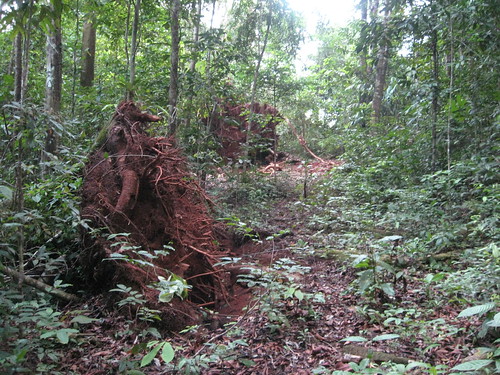 This post is going to pick up where the previous Costa Rica post left off because it is important to understand. When most people think of rain forests like the ones that exist in Costa Rica they think of plentiful large plant life and lots of exotic animals. This often leads to the association of plants in more temperate areas that have extensive amounts of soil under them. Well what you should notice based on the picture to the left [photo of a root ball on a tree in Costa Rica by author, I could not find a more temperate forest root ball to compare it to so if you know of one feel free to post the link below] is that this is not true. The actual soil in most rain forests is typically very thin but why is this and what does this have to do with conservation?
This post is going to pick up where the previous Costa Rica post left off because it is important to understand. When most people think of rain forests like the ones that exist in Costa Rica they think of plentiful large plant life and lots of exotic animals. This often leads to the association of plants in more temperate areas that have extensive amounts of soil under them. Well what you should notice based on the picture to the left [photo of a root ball on a tree in Costa Rica by author, I could not find a more temperate forest root ball to compare it to so if you know of one feel free to post the link below] is that this is not true. The actual soil in most rain forests is typically very thin but why is this and what does this have to do with conservation?Well the reason for this is due directly to the large amount of plants and animals along with the large amount of rain that occur in rain forests. When a dead organisms falls to the ground in a more temperate forest decay begins immediately but is slowed by a lower amount of rain and as one goes further north colder winter temperatures. In the rain forest you have warm humid climatic conditions year round, these are ideal conditions for decomposers so decomposition takes place very quickly. This means in order for plants and animals to get nutrients from decomposing organisms they must be able to do so quickly so this leads to a huge competition for these nutrients and with so many organisms competing for these nutrients the soil very quickly depletes the soil.
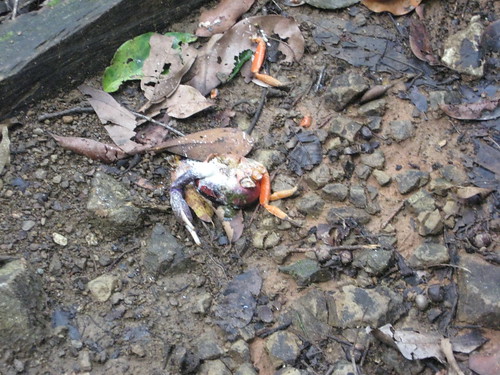 Rain also effects the soil in any given environment. If a farmer clears land then it proceeds to rain the rain will wash away some of the soil. The same thing occurs in nature in forests as well. In a temperate forest the rain may wash away some of the soil but typically plants grow up in the thicker soil before the rain has a chance to wash it away and the plants help lock down the soil. In rain forests we have a perfect storm we have already thin soil and we have plentiful pretty much daily rain so before plants have a chance to start growing a lot of the soil is lost [photo at right of a dead crab, you can ignore this for this post on very depleted soil by author]. This leads to areas where the soil remains exposed we end up with typically iron and felsic rich soils. These soils do not have the nutrients that are needed to support plant life and do to the large amount of rain it is hard to get plants to regrow in these areas. So what does this mean?
Rain also effects the soil in any given environment. If a farmer clears land then it proceeds to rain the rain will wash away some of the soil. The same thing occurs in nature in forests as well. In a temperate forest the rain may wash away some of the soil but typically plants grow up in the thicker soil before the rain has a chance to wash it away and the plants help lock down the soil. In rain forests we have a perfect storm we have already thin soil and we have plentiful pretty much daily rain so before plants have a chance to start growing a lot of the soil is lost [photo at right of a dead crab, you can ignore this for this post on very depleted soil by author]. This leads to areas where the soil remains exposed we end up with typically iron and felsic rich soils. These soils do not have the nutrients that are needed to support plant life and do to the large amount of rain it is hard to get plants to regrow in these areas. So what does this mean?This basically means that if we cut and burn and start trying to farm is these types of environments we lose most of the soil very quickly so we need more land. The land that had been farm land does not grow any plants anymore and continues to become more and more enriched in iron etc and gets more and more depleted in nutrients. This land eventually becomes almost rock like and will not grow plants so the farmers need more land so they slash and burn more land in the forest to be able to grow more crops, this is a big problem in places like Brazil.
Humans need food, however, so we need to do something. Well there are a couple ways to address this the first is that these countries could import food from countries that do not have similar problems. This is expensive, however, and leaves that country open to manipulation by foreign countries in exchange for food and as such is not preferable. The other main option is a crop rotation pattern. You could allow native plants to grow for a little while develop a more native soil pattern then cut it back and farm it for a couple of years then allow the forest to come back. This idea in and of itself isn't perfect and in the long run could prevent a country from growing enough food to support itself.
So which is best? I can't say and in fact their could be other options that I did not list here, feel free to put some in the comments section. It is important to note that in many parts of Costa Rica the locals have, however, taken advantage of the more natural way of growing food in many areas and if you stay try to stay at a ecolodge. These ecolodges typically produce their power and get food from sustainable sources which is good for Costa Rica and the world in general. The next post will also partially deal with conservation but in a slightly different way, as always I more than welcome your questions or comments below.
Wednesday, August 3, 2011
Fire Breathing Dinosaurs?
In Potholer54's continuing nominations for this year's Golden Crocoduck award he nominates the man who first popularized the idea about dinosaurs having too small nostrils...well just watch the video.
Artifical Sweeteners
I have been moving across the country so I have obviously failed at finishing my Costa Rica series and I have yet another National Park series post to write, but while I finish unpacking enjoy yet another great video by C0nc0rdance this time discussing the actual science behind artificial sweeteners and do they really give you cancer, as a diabetic I found this a helpful video (note: this video is 24 minutes long).
Monday, July 25, 2011
Energy Efficiency
Greenman3610 has a new video out showing that even if politicians don't want to believe it companies and private individuals have been slowly trying to become more efficient in their energy usage.
Tuesday, July 19, 2011
Geology of My Trip to Costa Rica

This article is a continuation of the series that I started a few days ago discussion several select topics in relation to my recent honeymoon to Costa Rica more specifically the Osa Peninsula. Now I am going to lead this article off by admitting that for the most part this topic seems to be under researched overall. There are a lot more personal observations in here than there are sources to peer reviewed published citations, which I am pretty upset about personally, so I do recommend you do your own research to find out more. I should point out that there are 3 sources (here, here, and here) that if I would have had access to them may have added some to the discussion here, so if you have read them feel free to post anything you know in the comments.
Overall Costa Rican Geology
The map at the top of the article was first published by the USGS in 1987. It has since been updated and digitized in 1996 by Paul G. Schruben, see larger version of the map here. So why am I using a map from 1987, the map is only a year younger than I am that should say something? Well the reason is that this is the only geologic map of the country that I could find so I am sure that it is slightly out of date. On another note here is the website for the Costa Rican Geological Survey.
Two things I notice right away just by looking at the map is that there is a lot of igneous rocks in the country and that there are not rocks visible on the surface that are older than the Jurassic. Both of these things exist for the same reason. When the continents first started rifting apart from the super continent of Pangaea North and South America were not connected, at least not in the same way they are today. This rifting because in the late Triassic/early Jurassic and the rates and directions of spreading varied in different parts of the Atlantic. This is why the oldest rocks are Jurassic in age. For millions of years the two Americas remained separated but eventually the Pacific Plate began to subduct under the North American Plate and the Caribbean Plate. This subduction caused more and more of Central America to be pushed up so for a bunch of volcanic islands to what we have in Costa Rica and Panama now, this initiated what is known as the Great American Interchange. According to discussions that I had while in country the Pacific Plate underwent a very shallow subduction this is what caused many of the volcanoes in the center of the country become dormant or extinct. These seems plausible but I don't know enough about the study in the area to be able to say for sure, I am going to admit here that Igneous and Metamorphic rocks were never my strong suit so I welcome anyone else to say if they know better.
Geology of the Osa Peninsula
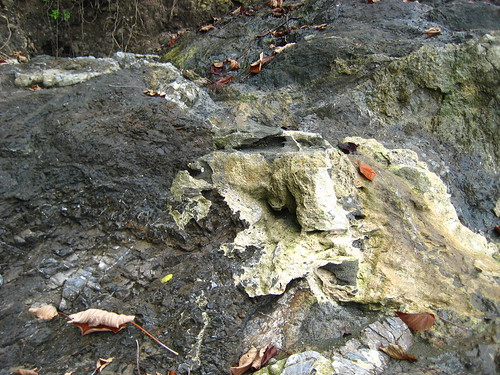 The Osa Peninsula and the Gulfo Dulce represent a very unique geologic set up compared to the rest of the country. A lot of travel brochures refer to Gulfo Dulce as a "tropical fjord" due to the great depth of the gulf and the steep drop-off to that depth as well as the surrounding land being mountainous. Fjord by definition cannot form in tropical environments because they need to be formed by glaciers, which this gulf was not, and they need to have more of a u-shape as well as having the mountain slopes forming right up to the edge of the water. But what explains the great depth?
The Osa Peninsula and the Gulfo Dulce represent a very unique geologic set up compared to the rest of the country. A lot of travel brochures refer to Gulfo Dulce as a "tropical fjord" due to the great depth of the gulf and the steep drop-off to that depth as well as the surrounding land being mountainous. Fjord by definition cannot form in tropical environments because they need to be formed by glaciers, which this gulf was not, and they need to have more of a u-shape as well as having the mountain slopes forming right up to the edge of the water. But what explains the great depth?This is actually a pretty simple answer the Osa Peninsula is composed primarily of basalt. Basalt is a rock that is typically associated with ocean floor rocks and differs from continental igneous rocks which tent to have more silica in them and as such are actually less dense than basaltic rocks. So the depth of the Gulfo Dulce is due to the fact that as the Pacific plate subducted under the Caribbean Plate the Osa Peninsula was pushed up on the Pacific plate side. So the gulf actually represents the spot where the Pacific plate is subducting and is just a continuation of the trench that runs along the Pacific coast of most of South and Central America. But why did the Osa Peninsula not subduct with the rest of the Pacific Plate?
A completely honest answer is that we (or maybe just I) don't know. This is one of the great things about science is that we can admit that but I can put through a couple of hypotheses that can eventually be tested. The first one is that the Osa Peninsula represents a spot where the Pacific plate has bent to such a high degree that it caused the Peninsula to be pushed up above water and eventually it will be subducted eventually. Now by itself I don't think this explains the Peninsula or we would expect to see a great many more islands like this following the boundary of the Pacific Plate. Another possibility is that for some reason the basalt that forms the rocks on the Osa Peninsula is less dense than the normal basalt. As I explained above silica rich rocks tend to be less dense than the basaltic rocks and running through the basalts visible on the beach were many many quartz seams. Quartz is made up of Silica and Oxygen and is a typical constituent of continental rocks, it is also the main constituent of most beach sands. This would have made the rocks less dense and more likely to but uplifted and less likely to be subducted which would cause the Osa Peninsula to stick up and eventually be accreted to the mainland of Central America. Now I will admit I like this last one better but it is honestly just a very basic hypothesis.
One more thing I hadn't noticed that there are supposed to be a lot of sedimentary rocks on the Osa Peninsula. Now while these break down before they can be seen on the surface and are likely just covering the basaltic rocks they aren't talked about much. Something you may notice in the picture that I posted at the start of this section is that yellow staining on the basaltic rocks, this picture was taken by the author and shows some of the rock visible on the Pacific side of the Osa Peninsula. Soil is thin in the area and most of these smaller streams don't carry much in the way of physical sediments what this yellow staining looked a lot like to me is travertine. This could be resulting from the few limestone rocks on the peninsula dissolving and the calcite reprecipitating on the rocks at the beach, if you want to know more about travertine look at my two posts on two of the caves in the National Park system, here and here. This post went far longer than I would have liked and there is another aspect I would like to cover that I can tie into another post so that is what I will try to do, also I should point out that I only just barely touched on some complicated topics so if you have any questions about any of that let me know. If you want to read a little bit more about this area geologically read this article from 2009 in Earth Magazine.
Saturday, July 16, 2011
New Twist on a Famous Image
Although it isn't exactly accurate SMBC has a new take on the famous progress of evolution. Make sure you click on it to appreciate the image fully.


Cell Phones
I have discussed a few times in the past the cell phones cause cancer idea, including a small rant in this post, but I think xkcd has it right in their comic from yesterday.


Friday, July 15, 2011
Costa Rica!!
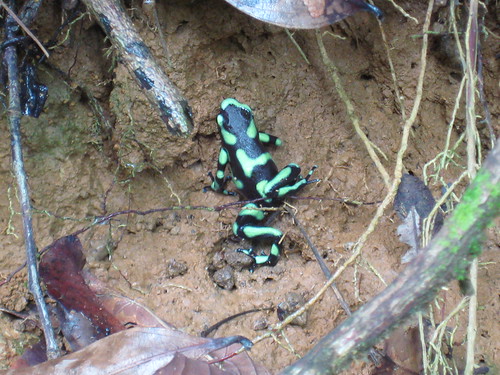 So as I mentioned in a previous post I recently got married, for our honeymoon my wife, still have a haven't gotten used to typing/saying that yet, and I went to Costa Rica [photo at left of a Green and Black Poison Dart Frog (Dendrobates auratus) by author]. There will be a couple of posts in the next few days about some things I found interesting/want to discuss about the country. I have two more posts that I have to finalize and I may be able to squeeze out one more but we will see. This post is going to serve more as an introduction to this little mini-series.
So as I mentioned in a previous post I recently got married, for our honeymoon my wife, still have a haven't gotten used to typing/saying that yet, and I went to Costa Rica [photo at left of a Green and Black Poison Dart Frog (Dendrobates auratus) by author]. There will be a couple of posts in the next few days about some things I found interesting/want to discuss about the country. I have two more posts that I have to finalize and I may be able to squeeze out one more but we will see. This post is going to serve more as an introduction to this little mini-series.As with everything I try to do here I will avoid politics as much as possible. This will be for 2 main reasons, the first being I just try to avoid politics in my posts as much as possible anyway (although I am sure some people may feel that my discussion on global warming is political and unfortunately it has to be to some degree) and the second and most important is that I know nothing about politics in Costa Rica. This all being said some of the topics I discuss will touch on some potentially political topics.
One other thing I am going to try to avoid is making this sound like an advertisement for the resort that my wife and I stayed at. This will be the only post that I will explicitly state the name of the hotel, as well as link to their website, and this is because I am going to openly admit upfront that I did not see much of the country so my posts will only be about the area that I know and I want to be honest with you about what I feel could be a potential bias*.
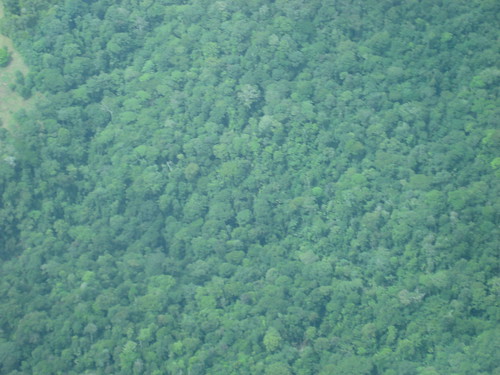 So now that I am done with that (took much longer than I expected) lets talk a little bit about the country itself [photo at right taken flying over a forested area of Costa Rica by author]. Costa Rica is located in southern Central America south of Nicaragua and north, although more west since Central America makes a turn in Costa Rica, of Panama. The country is just a little bit smaller than the state of West Virginia in regards to square mileage (~20,000 sq mi/~51,000 sq km for Costa Rica to ~24,000 sq mi/~63,000 sq km) but it has more than double the population of West Virginia (~5 million for Costa Rica to ~2 million for West Virginia). As you can imagine this is a much greater population density for Costa Rica as compared to West Virginia but most of the population is located in one region of the county known as the central valley. This area is the area of the country where San Jose is located. This area should be great for farming due to the rich volcanic soil, see geology is important, while the areas outside of this used to be primarily rain forest which, as I will discuss in a future post, very quickly becomes poor farming environment. The country is highly mountainous, which for anyone who has driven through West Virginia will tell you is another similarity between these two places, and this can be explained by the geology of the area, which will be discussed in greater depth in a future post.
So now that I am done with that (took much longer than I expected) lets talk a little bit about the country itself [photo at right taken flying over a forested area of Costa Rica by author]. Costa Rica is located in southern Central America south of Nicaragua and north, although more west since Central America makes a turn in Costa Rica, of Panama. The country is just a little bit smaller than the state of West Virginia in regards to square mileage (~20,000 sq mi/~51,000 sq km for Costa Rica to ~24,000 sq mi/~63,000 sq km) but it has more than double the population of West Virginia (~5 million for Costa Rica to ~2 million for West Virginia). As you can imagine this is a much greater population density for Costa Rica as compared to West Virginia but most of the population is located in one region of the county known as the central valley. This area is the area of the country where San Jose is located. This area should be great for farming due to the rich volcanic soil, see geology is important, while the areas outside of this used to be primarily rain forest which, as I will discuss in a future post, very quickly becomes poor farming environment. The country is highly mountainous, which for anyone who has driven through West Virginia will tell you is another similarity between these two places, and this can be explained by the geology of the area, which will be discussed in greater depth in a future post.My wife and I only spent one night in San Jose we spent most of our time in another part of the country. The area we stayed in was known as the Osa Peninsula, which surprisingly has a very crappy Wikipedia page. The peninsula is the furthest southwestern point of the country and my wife and I stayed on the tip of the peninsula. This part of the country is one of the most important ecological places in the world and according to everyone I talked with while there as well as a couple of other sources (which I can't find now) call the area one of the most ecologically diverse places on the planet if you want to know more about the ecology of the Osa Peninsula I recommend the Wikipedia page on the Corcovado National Park.
We stayed at a hotel named Bosque del Cabo. This hotel was interesting in that our room was an individual little cabin like structure that sat right near the drop off for the Pacific Ocean. The overlook provided the opportunity to watch plenty of birds as well as a chance to see all four of the monkey species that live in Costa Rica. This hotel, like many others on Osa Peninsula, is what is known as an ecolodge. The ecolodges down there try to be as much a part of nature as they can while still providing luxury amenities. Most of the power was created using solar power, some appears to have been made using hydroelectric sources as well, each cabin had their own individual solar water heater, the resort is tries to recycle as much of their waste as possible, and most importantly the forest, with the exception of right around the cabins, is allowed to grow free which allows the chance for the wildlife to live free nearby and actually get extremely close to the cabins. If you are looking for a place to stay if you visit Costa Rica I recommend finding an ecolodge on the Osa Peninsula it is worth the cost, and I will give them one more shout out but I personally recommend Bosque del Cabo.
With the basic introduction out of the way, far longer than I wanted to write as well, the rest of the posts in this series will focus on topics that are more commonly seen on this blog, things like geology and conservation, so I hope you enjoy the mini-series.
*I will admit I don't think bias is the proper word choice but I can't figure out what would be so you will have to deal with my really narrow vocabulary!
Wednesday, July 13, 2011
Dinosaur Eggs and Creationism
Potholer54 continues to feature his Golden Crockoduck award nominees, this one deals with dinosaur eggs and how they somehow show that a global flood occurred.
Statistics are Important!
While his videos always take a more medical approach to science the practice is a science so I have always enjoyed C0nc0rdance's videos. This particular one shows why a scientist needs to have a basic understanding of statistics. It also shows why single studies, like the Wakefield MMR paper, don't prove anything and why I was so upset with the World Health Organization (WHO) when they issued their statement saying that cell phones might cause cancer, that was until I saw they had it in the same category as things like coffee aka if they do it will be hidden in the noise anyway (although they probably don't since as far as physics are concerned there is no mechanism, ok I will get off this topic now). Anyway enjoy!
The Earth is NOT facing a mini-ice age!!!
So the past few weeks have been pretty hectic for me as I had to drive about 26 hours to get home, I got married, went on our honeymoon, and then had to get back here to west Texas so sorry about the lack of posts. I have a couple of posts in the works so just hold on and we will get back to some new content. For the time being I am getting caught up on some YouTube videos so there is a chance there will be a lot posted here over the next few days. This one is from Potholer54 taking to task all of the people who are using a recent study on sun inactivity to say that we are entering a mini-ice age.
Monday, June 20, 2011
Friday, June 17, 2011
I Want to Believe
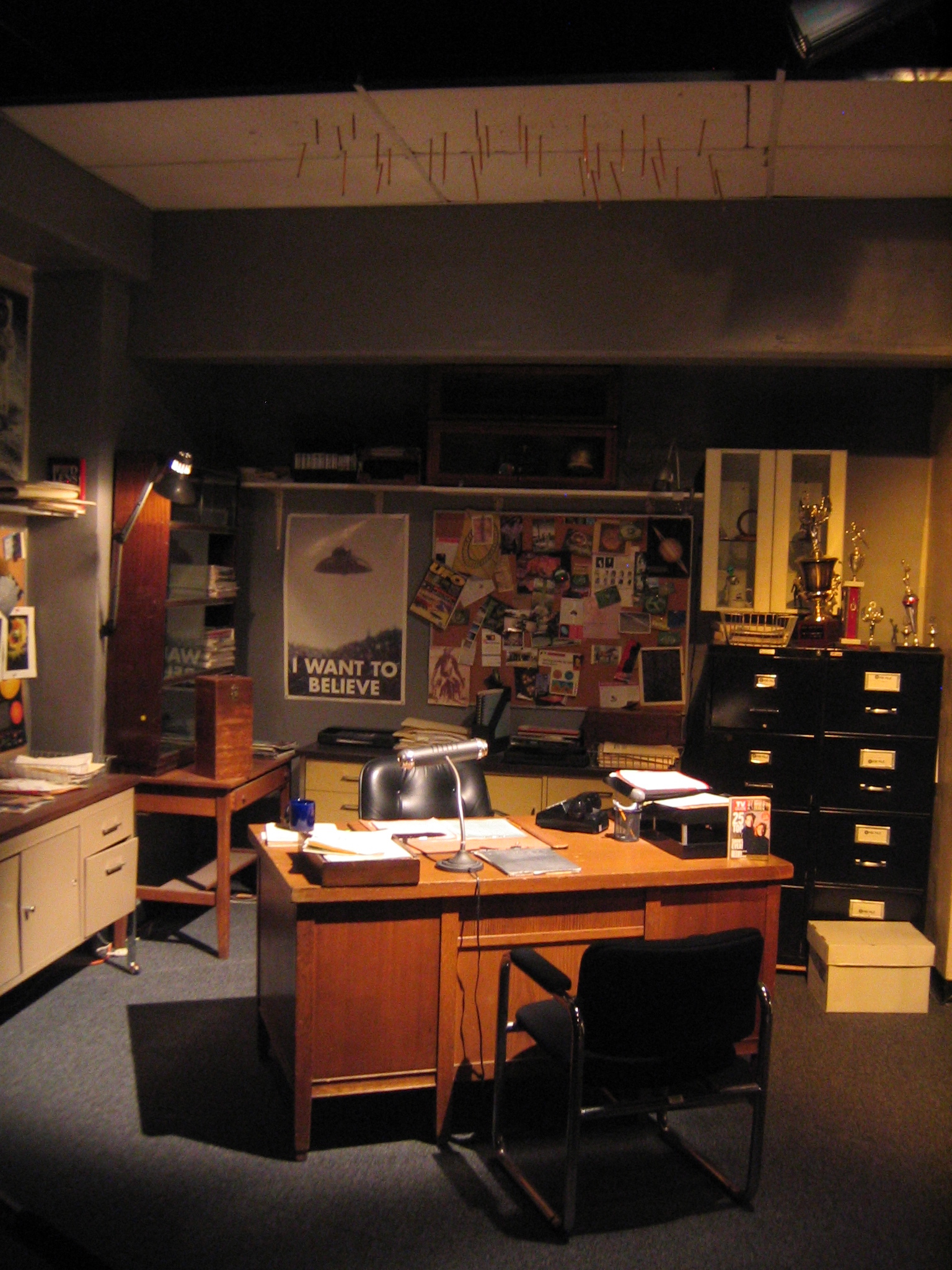 The Fox television show The X-Files was a huge hit show in the 1990s. The main plot of the show centered around two FBI agents, Fox Mulder (played by David Duchovny) and Dana Scully (played by Gillian Anderson), as they investigated paranormal activity occurring around the country. I grew up and loved that show I would watch it every Sunday night in my room with the lights turned off, needless to say that led to a lot of really sleep Mondays. One of the things that always stuck out in my mind was a poster that hung in Mulder's office [Image at left of Mulder's office from Wikimedia by Alistair McMillan] with a U.F.O. and block lettering saying "I WANT TO BELIEVE". At the time I wasn't sure why but I in this show rich in cryptozoology and the paranormal I was always drawn to that poster.
The Fox television show The X-Files was a huge hit show in the 1990s. The main plot of the show centered around two FBI agents, Fox Mulder (played by David Duchovny) and Dana Scully (played by Gillian Anderson), as they investigated paranormal activity occurring around the country. I grew up and loved that show I would watch it every Sunday night in my room with the lights turned off, needless to say that led to a lot of really sleep Mondays. One of the things that always stuck out in my mind was a poster that hung in Mulder's office [Image at left of Mulder's office from Wikimedia by Alistair McMillan] with a U.F.O. and block lettering saying "I WANT TO BELIEVE". At the time I wasn't sure why but I in this show rich in cryptozoology and the paranormal I was always drawn to that poster.A couple (part 1 and part 2) of recent posts over at Love in the Time of Chasmosaurs by David Orr got me thinking about that again. As a scientist I have learned to not "believe" anything unless it is supported by the evidence but I still find myself turning on shows like Finding Bigfoot and Monster Hunters sort of as a guilty pleasure when they are on during the weekend and there is nothing better on T.V. but I don't know why. Or at least I didn't until I was finishing up the second post by David the truth is I WANT TO BELIEVE.
As David discusses in his first post mainstream science and cryptozoology have a tenuous history at best. While I won't rehash all his arguments here, seriously go read his posts, it basically comes down to much of the hunting for mythological beasts does not follow what would typically be described as science. Take the search for Bigfoot as an example every movement in the woods of Washington every fur every unidentifiable footprint every black or brown blur on videos is taken as evidence of this mysterious ape. This is the reason why there are very rarely scientists on these shows, and the ones that are normally get drowned out behind the all of the pseudoscience. This does not mean that actual scientists don't look into these events as David points out the discovery of a living pterosaur, or a bigfoot, or a Nessie would bring droves of people that want to find out more about it. Even at the great blog Tetrapod Zoology, Darren Naish often discusses cryptozoology, and as he points out we are more likely to find an unknown creature in the depths of the ocean than in the forests of Washington.
One major flaw I see in modern cryptozoology, or ufology, is that it assumes that ancient cultures did not have the imagination that we have today, or in the case of ufos the willpower to build pyramids etc. We know that we have many advances from the ancients in the form of technology and the understanding of science but that does not mean that didn't have the ability or even the smarts to think up their own legends and to think up ways to build impressive buildings. We have the ability to accomplish what we do today because of those that came before us or to use the phrase common in science, "We stand on the shoulders of giants." To take away the accomplishments of the past takes away not only what they accomplished but what we accomplish today because it means that we as a species do not have the ability to do great things without help. These are things that are often cited as proof of cryptid animals and ufos, this isn't evidence it is condescending.
As a scientist by training I understand the need for evidence and so far none has been presented for these phenomenon I have a hard time thinking of these things as existing. But I have always had an interest in these things for some reason or another. It is on this point that I refer back to Agent Mulder's office, while he did believe he didn't have any want to that poster has more meaning to me. I may not believe in these phenomenon but a part of me definitely want to so let me conclude by saying:
I WANT to believe
Thursday, June 16, 2011
Debunking Monckton 5
Potholer54 finally finished his series debunking Christopher Monckton (see parts 1, 2, 3, and 4) that he last posted a video on in March. He has done a great job with this series and I don't blame him for finishing up the series without debunking all of Monckton's claim but I am sure that there will be future videos not just by Potholer54 who will be debunking these claims.
Monday, June 13, 2011
Science and the Media
So anyone who has studied science for any length of time knows that the media will eventually not get something right about it. Often times it is just simple mistakes that you can forgive someone who hasn't spent their whole life studying science for (although since their job is science journalism should we?). I have covered the idea behind this topic in the past with journalists referring the pterosaurs as dinosaurs, hint they are not, so I was glad to see this video by Potholer54 discussing some of the reasons why the media screws up science. This is labeled part 1 so expect future posts as he posts his new videos.
Corn Syrup the Truth
C0nc0rdance as with all of his videos does an excellent job of showing exactly what the peer reviewed scientific literature actually says this time dealing with that all time demon, at least in some people's eyes, High Fructose Corn Syrup.
Friday, May 27, 2011
Ring Species
In his newest video Potholer54 nominates one more person to this year's Golden Crocoduck. In the video he discusses ring species, I will leave the discussion as to what they are to him but I use a similar example of ring species when trying to teach about evolution and speciation.
Thursday, May 26, 2011
David Mitchell deals with Climate Change
This was pretty funny! I wish he was wrong but David Mitchell brings up good points, I love to drive etc but unfortunately he is right.
Sunday, May 22, 2011
Museum Visit #4
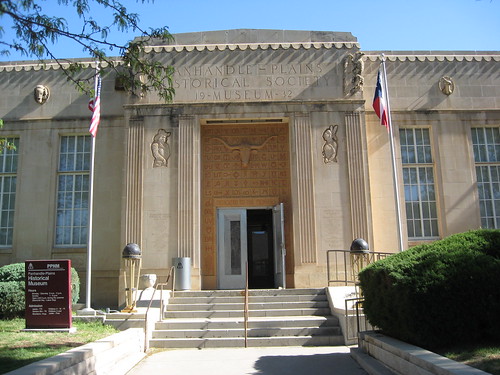 It had been a while since I had been to a museum so when one of my fellow graduate students suggested making a trip to Panhandle-Plains Historical Museum (Wikipedia article) I jumped on the opportunity. He had the option to make the trip a couple of months ago but had decided not to go but back then I had done some research on the museum which made the decision to go even easier when he asked. So early on the morning of May 14th a group of us set off from Lubbock, TX to take the hour and forty-five to two hour trip up to Canyon, TX to the museum.
It had been a while since I had been to a museum so when one of my fellow graduate students suggested making a trip to Panhandle-Plains Historical Museum (Wikipedia article) I jumped on the opportunity. He had the option to make the trip a couple of months ago but had decided not to go but back then I had done some research on the museum which made the decision to go even easier when he asked. So early on the morning of May 14th a group of us set off from Lubbock, TX to take the hour and forty-five to two hour trip up to Canyon, TX to the museum. This museum claims to be the largest history museum in the state of Texas and I would not doubt that it is for a second. This is a pretty impressive for a state that is as obsessed with its history as Texas is. The museum is deceivingly large looking small on the outside and located on the campus of West Texas A&M University in a fairly small town outside of Amarillo, TX. The main focus of the museum is on the Panhandle of Texas.
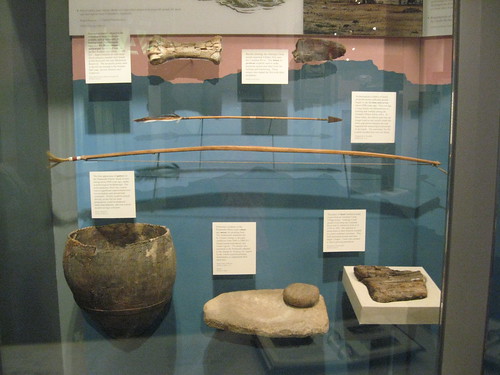 Walking into the museum you get a taste of what you are going to see in the lobby. There is a small display on Native Americans from the region a small paleontology section and a small display on history of European Settlers in the region. It cost about $10 to get in but it was well worth the price.
Walking into the museum you get a taste of what you are going to see in the lobby. There is a small display on Native Americans from the region a small paleontology section and a small display on history of European Settlers in the region. It cost about $10 to get in but it was well worth the price.The first hall we walked through talked about the Native Americans that lived in the area. There were plenty of artifacts used by Native Americans to farm as well as gather and hold water and other important aspects to life. The exhibit was set up based on three aspects for living in the area, which for some reason I can't remember right now, but included things like food water and shelter, for this reason the Native American artifacts were scattered throughout the area. There is a very brief discussion on why farming is possible in the area, pumping water from the Ogallala Aquifer, and some of the harm we are doing to the aquifer by farming using it. While this historical portion is interesting it was actually the reason we went nor is it what I am going to focus on now.
 Entering into the paleontology section you are greeted by a large mural with 3 casts in front of it. These represent the panhandle during the age of mammals, I am not sure specifically sorry you get the generic title there, and include a three-toed horse as well as a Gomphothere. There is then a quick summary of life through time starting in the Cambrian and moving through the Permian, in other words the Paleozoic. Each time section has fossils that represent organisms found during those time periods, most of these are small invertebrates and since these times are poorly represented or not represented at all in Texas they are just kind of glanced over. Entering into the Permian there are many fossils that have been found in not just Texas but in the panhandle.
Entering into the paleontology section you are greeted by a large mural with 3 casts in front of it. These represent the panhandle during the age of mammals, I am not sure specifically sorry you get the generic title there, and include a three-toed horse as well as a Gomphothere. There is then a quick summary of life through time starting in the Cambrian and moving through the Permian, in other words the Paleozoic. Each time section has fossils that represent organisms found during those time periods, most of these are small invertebrates and since these times are poorly represented or not represented at all in Texas they are just kind of glanced over. Entering into the Permian there are many fossils that have been found in not just Texas but in the panhandle.Now is a good time to point out that many of the actual fossils in the museum from the panhandle were found during the 30's and 40's by Works Progress Administration (WPA) digs. These digs were "shovel-ready" jobs that President Franklin D. Roosevelt had promised just to give people jobs so they had money so they could spend said money to improve the economy. Many of these fossils came from nearby Palo Duro Canyon State Park (Wikipedia article, and tourist page) which is why they are stored in Canyon, TX. With as many Permian rocks as are in the State Park the Permian fossils are under represented. Part of this is because while Permian fossils are well known from the state they are actually very poorly represented in the Quartermaster Formation, the Permian aged rocks in the state park.
The Triassic fossils do not suffer the same fate. This is because the Triassic is represented by the Dockum Group which in the Panhandle has produced plenty of fossils and still does today, this is the work that the Museum of Texas Tech University Paleontology Division (MoTTU-P) focuses on. So there are plenty of phytosaurs and metoposaurs on display in the Panhandle-Plains Museum. The remainder of the Mesozoic is underrepresented in the Panhandle (there is some Cretaceous aged rock on the South to Southeastern edge of the caprock) so there are very few fossils on display from the Jurassic and Cretaceous. They did have some sauropod fossils, likely casts, as well as a few other Mesozoic casts including the centerpiece of the paleontology wing a cast of Allosaurus. The one area that did anger me was they had the sauropod fossils labeled as "Brontosaurus", for those who don't know "Brontosaurs" has long since been synonomized with Apatosaurus (go type Brontosaurus into Wikipedia), this set out a minor moment of rage, the fact that the skull was of a Diplodocid didn't help much.
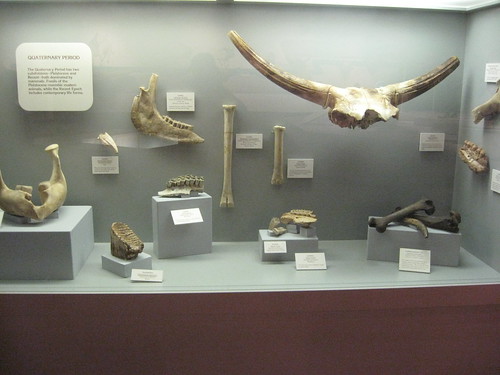 But a major portion of the Paleontology exhibit focused on the fossil mammals that had been found in the area. The panhandle is home to three North American Land Mammal Ages (NALMA); Clarendonian, Hemphillian, and Blancan. These were where many of the fossils were from and there was case after case of fossils from these ages. I can tell that the exhibit hadn't been updated in a while because many of the genus and species names are outdated and have been synonomized with others, I discuss this on the appropriate images in my Flickr set on the museum. I was impressed by this massive display of mammal fossils because this is not typically what you see at most museums but if this is what they have the most of why not. They also had a display talking about horse evolution something which is impressive for West Texas.
But a major portion of the Paleontology exhibit focused on the fossil mammals that had been found in the area. The panhandle is home to three North American Land Mammal Ages (NALMA); Clarendonian, Hemphillian, and Blancan. These were where many of the fossils were from and there was case after case of fossils from these ages. I can tell that the exhibit hadn't been updated in a while because many of the genus and species names are outdated and have been synonomized with others, I discuss this on the appropriate images in my Flickr set on the museum. I was impressed by this massive display of mammal fossils because this is not typically what you see at most museums but if this is what they have the most of why not. They also had a display talking about horse evolution something which is impressive for West Texas.Moving on from the fossils there is a brief overview of the geology of Palo Duro Canyon, something which I am planning a post on since we went there right after the museum. There is then a display on windmills, if you really want to see something on that come down to Lubbock and go to the American Wind Power Center (Wikipedia article), and old cars. The second floor had lots of guns, up through the better part of the Cold War, then a discussion on oil drilling, saddles, and lots of art. The basement had a few hidden gems including taxidermy displays of animals that live or used to live in the area. We did not get to see Pioneer Town because it was being renovated.
Despite its few faults the museum is worth stopping by for anyone in the South Plains and if you are in the area for any reason it is worth stopping by. We got there around 10am and left the museum at 2pm so make sure to leave plenty of time. I also took over 600 pictures, mostly because I am a huge nerd, but make sure you are ready to take lots of pictures. I think the museum gets forgotten about by people who go to Palo Duro State Park but they should really take the time to go see the museum. Sorry this post ended up being so long but when I see a hidden gem I want to make sure other people notice it as well. All images included in the post were taken by the author and if you wish to see more you can go to my Flickr set on the museum or for pictures that include those from Palo Duro my Flickr set that includes both.
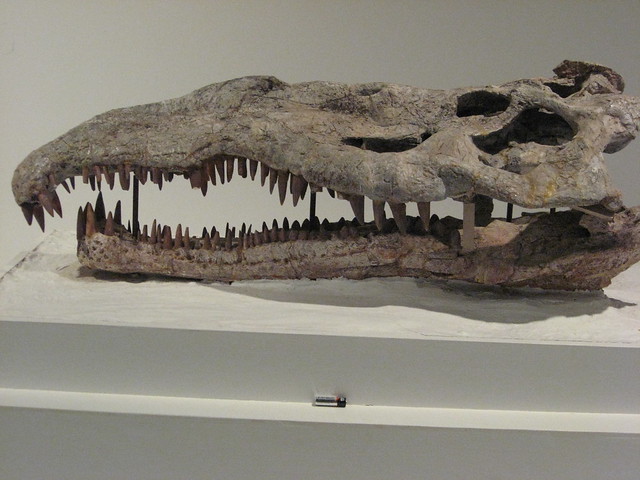
Museum visits page
Subscribe to:
Posts (Atom)


